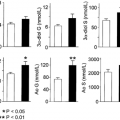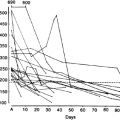ETIOLOGY OF ERECTILE DYSFUNCTION
Part of “CHAPTER 117 – ERECTILE DYSFUNCTION“
OVERVIEW
The literature contains several studies in which men with ED were evaluated with SRE testing to differentiate organic and psychogenic causes for their condition. Other tests were used to further classify the organic causes. Two hundred and fifty-six men with ED were examined by a psychiatrist and a urologist, and then studied in a sleep laboratory using measurements of SREs. Thirty-six percent had organic ED, 38% had psychogenic ED, and 26% had a mixed or uncertain diagnosis.70 Androgen deficiency or hyperprolactinemia was noted in 17.5%. Another study evaluated 172 men with ED aged 19 to 60 years.71 Patients taking drugs strongly suspected of causing ED were excluded from the sample. Abnormal SREs and abnormal penile rigidity were observed in 62% of the patients, low penile blood pressure was noted in 37%, low serum T or mildly to moderately elevated prolactin values were observed in 22%, and Peyronie disease was noted in 8%. The evaluation of 121 older men with ED (mean age 68 ± 5.3 years) revealed 21% with a vascular cause for the ED, 28% with a neurogenic cause, and 30% with combined vasculogenic and neurogenic causes.72 Drug-induced ED accounted for 4%, hypogonadism for 2.9%, and Peyronie disease for 1.3%. Abnormal SREs without identifiable cause occurred in 3.9% of these patients. Thus, the frequency of specific causes varies. Differences likely depend on referral patterns and how the reported group is defined. In nearly all reports, however, organic causes predominate. Other disease associations are listed in Table 117-3. Because many patients have benign prostatic hypertrophy (BPH) and prostate cancer, noting reported incidents of ED with different treatments for these conditions is useful.
BENIGN PROSTATE HYPERTROPHY AND PROSTATE CANCER
Treatment of BPH and prostate cancer frequently is associated with ED. In one study, patients were treated with one of several therapies.73 ED was noted in 1 of 40 patients treated by open prostatectomy, in 3 of 89 men treated with transurethral prostatectomy after 6 months, in 1 of 33 men treated with doxazosin for 6 months, and in 12 of 36 men treated with finasteride for 6 months. (This incidence of ED with finasteride therapy is much higher than that noted in the large multicenter trials [<5%].) In the Veterans Affairs cooperative study that compared management with watchful waiting and transurethral prostatectomy (TURP), TURP was not associated with increased ED.74
Prostate cancer is the second most common nonskin cancer diagnosed in men. The widespread use of prostate-specific antigen (PSA) testing to screen for prostate cancer has resulted in increased diagnosis at an earlier age and, consequently, at a stage when the disease is localized to the prostate. Radical prostatectomy and external beam radiotherapy are the modalities with the potential for curing this disease. Although some differences are noted in the incidence of ED between patients undergoing radical bilateral nerve-sparing surgery and those undergoing either unilateral or non–nerve-sparing prostatectomy,75,75a and between those receiving conventional radiotherapy and those receiving conformational radiotherapy,76 available data suggest that severe ED is common after both radical prostatectomy and radiotherapy. After surgery, ED is more likely to improve after several months. By contrast, ED tends to be less at 3 months than at 12 months after radiotherapy.77 In a metaanalysis, the probability of maintaining erectile function after radiotherapy was found to be 0.69 and after surgery was 0.42.78 In a study of Medicare beneficiaries, only 33% of men younger than 70 years of age who had radiotherapy and 11% of men who had surgery had erections sufficient for intercourse at follow-up, 3 or more years later.79,79a For men older than 70 years of age, only 27% of those who had radiotherapy and 12% of those who had surgery were potent. A randomized trial with sufficient sample size is sorely needed, however, to clarify the most curative and least detrimental therapies for different subsets of patients with prostate cancer. In addition to reflecting physician and patient biases that influence therapeutic choice, metaanalysis comparisons are limited to data available from studies that assessed pretreatment erectile function, stage of disease, age at treatment, and period of follow-up. Nonetheless, in men younger than 70 years of age, external beam radiation appears less likely to cause ED than surgery.80 Patients who had partial ED preop-eratively and those with preexistent diabetes or vascular disease are more likely to experience severe ED after surgery. Thus, ED is a likely side effect in men being treated for prostate cancer. Neurologic injury best explains surgically related ED in the majority of cases; vascular and neurologic injury represent probable causes after radiotherapy. Therefore, because the causes differ, the treatment response for ED also will likely differ for men undergoing different prostate cancer treatments.
ANDROGEN DEFICIENCY
Androgen deficiency is widely recognized as a cause of sexual dysfunction (see Chap. 115 and Chap. 116). Diminished libido, reduced ejaculate volume, and ED are common when androgen deficiency develops after puberty. If androgen deficiency occurs in the presence of gynecomastia, a late-onset deficiency of 17-keto-steroid reductase should be considered.81 ED and symptoms of androgen deficiency are usually manifest when T levels are <300 ng/dL. One study including 68 hypogonadal men and 105 eugonadal men concluded that the threshold for normal SREs is ˜200 ng/dL.21 The estimated incidence of androgen deficiency in unselected men with ED ranges from 2.1% to 23%.71,82,83,84 and 85 In a study of 1022 men presenting with ED, serum T was low (<300 ng/dL) in 107; however, repeat testing found normal values in 40% of these men.86 Therefore, confirmation of androgen deficiency is important. Limiting T assessment to patients with low sexual desire or abnormal physical examination misses 40% of the men with low T levels. This includes 37% of the men whose symptoms improved with androgen replacement.
Stay updated, free articles. Join our Telegram channel

Full access? Get Clinical Tree





